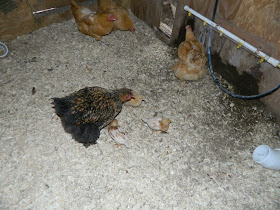Aren't they cute?
Momma has been given a real name by the daughter of a colleague of mine. "I" named her Lola, which I think is an adorable and fitting name for her. Much better than the boring "Momma" I've been calling her!
Lola has started taking her brood outside to free-range for short periods of time. The babies are growing up!
For the first time they have been mingling with the rest of the flock. I was afraid for them, since there's always the risk they'd be pecked to death by another chicken.
Happily, the flock pretty much ignored the babies. I only saw a baby get pecked one time. She was at the food when another hen came over to eat. The baby didn't move out of the way of the hen, so she got a peck on the back. That sent her running back to Lola, who seemed to say, "What did you expect when you don't yield to someone higher on the pecking order?"
Like all youngsters, they are learning their place in society and how to fit in.
DEEP LITTER
I've been using a technique called the "Deep Litter" (DL) method inside the chicken coop. Instead of cleaning out the bedding in the coop weekly or monthly, you just add more new litter on top of the old. The layers build up and compost right there on the coop floor. Coop cleaning happens only once or twice a year.
But doesn't it stink? Nope. Not if you're doing it right. If there is an ammonia smell, you don't have enough litter on the floor!
I use pine shavings on the coop floor. I started with about a 3" thick layer when I put Team Omelette in the coop back in July. My coop has a dirt floor, which is ideal for the DL method. But you can use DL with any type of coop floor.
All I do is add another couple of inches of fresh pine shavings every couple of weeks, or when it starts to look dirty in the coop. The fresh layer is added on top of the existing shavings.
If you start to notice an ammonia smell, your bedding is too wet. Throw some more bedding down, then rake it in to help dry things out.
Since I started the DL process in the summer, by the time winter set in there was a thick layer of litter on the coop floor. The composting action generates a small amount of heat, which keeps the inside of the coop five to ten degrees warmer than the outside air temp. Believe me, in the middle of a Colorado winter, those few additional degrees make a difference!
Now that it's time to get the garden ready for spring planting, it's also time to clean out the coop.
You can see how broken down and composted it all is.
Be sure to leave a thin layer of the old stuff so that the helpful microbes in it can get to work on all the new bedding and pooh that's about to be deposited.
I have a new ranch hand, "M", who came over to help me with this coop cleaning. We took four of these carts full of composted bedding out of the coop.
You can put all that old bedding into your compost pile. I'm simply digging it into the garden beds. It's mostly composted anyway.
There's still a small risk that the high nitrogen in the uncomposted, fresher pooh will burn the seedlings. It's a risk I'm comfortable with. There's not that much of it and it'll sit there for a few weeks to a month or so before anything is planted. I think it'll mellow out in that time and not burn the seedlings.
Now put down a nice layer of fresh bedding on the coop floor and start the DL process all over again.
Team Omelette loves it when there's a fresh layer of shavings in the coop. They busily scratch through to see if there's anything edible in it.
I'll let this build up through spring and summer then clean it out again in the fall. It doesn't get much easier than this! No more cleaning the coop every week. Using the DL method is really just composting inside your coop.
Along with my nifty feed and water systems, the DL method really cuts down on the amount of work it takes to keep a flock of chickens. Work smart, not hard!
Oh, if you decide the DL method is right for your flock, do not use diatomaceous earth or any pesticides in the coop. It'll kill off all of the helpful microbes and organisms that are working to compost the litter!
Good luck and let me know how it works for you.
There's no real reason for posting this photo of Kipp taking a siesta other than I think he's an awesome horse and riding partner!












Oh thank you! I am starting on the chicken adventure, also in a cold climate and a dirt floor chicken house. Your experiences are helping me greatly! I have four pullets the local Co-op raised and offered as a giveaway, now to choose the breeds of the other 10-15 birds I want....
ReplyDeleteHello, Farmwife! My flock has done well through some seriously cold temps. here. I only use heat lamps when it's single digit and below or else when the wind chill is that low. My flock includes Orpingtons, Wyandottes, Cochins, a Crested Polish and a Silkie Bantam. I haven't seen any frostbite or other signs of injury due to cold. I'm so happy you stopped by! If there's anything at all I can help you with, please give a shout.
ReplyDelete